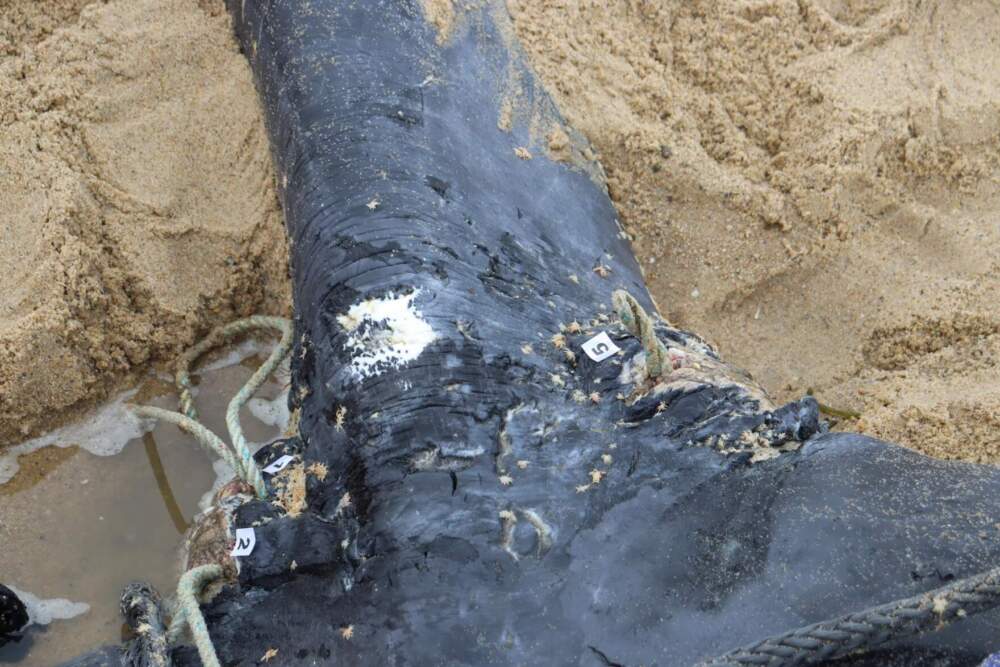Advertisement
Right whale found dead on Martha's Vineyard killed by chronic entanglement wounds, finds preliminary report

The critically endangered right whale that washed ashore on a Martha’s Vineyard beach died from “chronic entanglement wounds,” according to a preliminary report.
During a post-mortem exam known as a necropsy, experts from the International Fund for Animal Welfare (IFAW) noted how thin the young female was, with rope deeply embedded in her tail.
On Friday, several hours before the preliminary cause of death was announced, federal regulators identified the whale as “5120,” a 3-year-old that was first found with rope around her tail at just about a year-and-a-half old.
As the whale grew, the rope tightened, creating painful, stressful conditions.
“In the hundreds of necropsies I have been a part of, this was one of the most heartbreaking I have led,” said Dr. Sarah Sharp, Animal Rescue Veterinarian at IFAW. “This young whale had a deeply embedded chronic entanglement in line. Her entanglement was first identified in 2022, meaning that for nearly half of her short life, she suffered from this painful condition.”
Parts of the rope have been turned over to the National Fishery’s Service’s law enforcement arm, so gear experts can examine it and try to identify where it may have come from.
Sharp’s team members said they found no evidence of blunt force trauma, which would typically indicate a collision with a boat.
IFAW-led research revealed that between 2003 and 2018, nearly 90% of determinable North Atlantic right whale deaths were caused by boat collisions or entanglement in rope and fishing gear. Those factors have pushed the North Atlantic right whale population to stagnate at around 350 in recent years.
The painful history of “5120”
This right whale, the only known calf of Squilla (#3720), was born during the 2021 calving season. On Aug. 31, 2022, she was seen entangled for the first time about 48 miles east of Shippagan, New Brunswick, according to federal officials.
The entanglement proved serious, with multiple wraps of line around her tail and flukes, two small buoys at the flukes, and an estimated 200 feet of line trailing behind her.
It was an immediate concern for experts who began exploring how they might free her. As the 1-year-old grew, they knew the rope encircling her tail stock would likely tighten.
Then, a team from the Center for Coastal Studies in Provincetown thought they might have a lucky break when the whale was seen in January 2023 in Cape Cod Bay.
Their Marine Animal Entanglement Response team tried disentangle her several times, but found was no trailing gear to work with anymore, and inclement weather and distance from shore made it impossible to do more, officials said.
Advertisement
Whale #5120 was last seen alive in June 2023. Aerial observers for the Northeast Fisheries Science Center found her feeding with other whales 60 miles northeast of Shippagan, New Brunswick.
Her overall condition had declined and the wounds from the wraps of rope appeared to be more severe, officials said.
After the necropsy, she was buried on Aquinnah Wampanoag Trust land in a forested area. The Tribe plans to use the bones for educational and cultural purposes in the future.
The impact of the loss
Experts are waiting to finalize the cause of death until they can test samples collected during the necropsy, which can take weeks to complete.
Meanwhile, the overall fact of the whale’s death continues to devastate advocates who say extinction is coming for the species, if the whales aren’t protected.
Since 2017, nine right whales have been reported dead and another 70 have been found with serious injuries due to entanglement.
Advocates are calling for the adoption of on-demand or “ropeless” fishing gear to reduce the risk of entanglement. They’re also urging the federal government to strengthen laws around boat speed limits.
On Wednesday, a group of 48 North Atlantic right whales were seen southeast of Cape Cod in an areas with busy shipping lanes and voluntary speed limits.
Oceana Campaign Director Gib Brogan said that means at least 15% of the population is swimming in peril.
“Oceana’s recent report found that more than 80% of boats violated voluntary and mandatory speed zones established to help protect whales,” he said.
This story is a production of the New England News Collaborative. It was originally published by CAI.